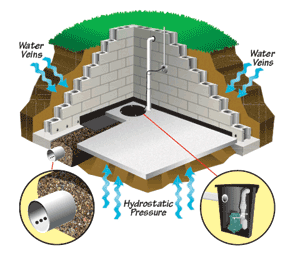Crawl Space
Crawl space Waterproofing can be done by most homeowners and is recommended to cut down on insect and water damage, mold and that musty odor that can penetrate the home from the damp ground in a crawlspace. While three different options are available, a combination of the three makes for the best possible waterproofing

Waterproofing
Exterior Considerations
- Properly grade the dirt away from the foundation. This slope is vital to waterproofing a crawlspace and may be the only step needed. If water does not drain away from the home, it will eventually find its way into the crawlspace. Use an aggressive slope, such as 1/2 inch per foot, to make sure the water flows quickly away from the foundation without having a chance to penetrate it.
Also consider gutter downspouts. If you have underground rainwater drainage, inspect the downspouts periodically to make sure they aren’t filled with debris that could cause the rainwater to spill out of the gutter or the base of the downspout and penetrate the crawlspace. For downspouts that simply end at the bottom of home’s exterior, add an extension that carries the water another 2 or 3 feet before it exits from the downspout.
Ground Penetration
- The most common crawlspace waterproofing technique is to cover the ground inside the crawlspace with thick plastic sheeting that is glued to the crawlspace walls and taped along the seams to stop water moisture from the ground passing into the crawlspace.
Rather than using the standard plastic sheeting available in most home improvement centers, purchase a purpose-specific product such as Foritfiber Moistop that is part of a system designed to prevent moisture penetration form the ground. The advantage to this system is the specially designed components such as tape and adhesive.
Waterproofing the Walls
- Waterproofing the walls can be done two ways. The easiest and more economical method is known as negative waterproofing and is done by coating the interior of the crawlspace walls with a product designed to waterproof concrete blocks or cement. These products, such as Drylock, are widely available at home improvement centers. They waterproof the wall by penetrating all the little holes and voids in the concrete and then expanding as they dry, forming an impenetrable layer on top of the block. Leaks can still occur, but it is much better than unprotected crawlspace walls.
Positive waterproofing involves exposing the entirety of the exterior crawlspace wall and footer by excavating the dirt from along the perimeter of the house. After this, scrub the walls and apply a waterproofing membrane to the crawlspace wall. This option will stop all water penetration through the wall, and is also the most expensive choice, one better left to professionals, as the better material is not available at retail stores.
